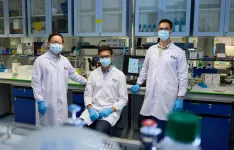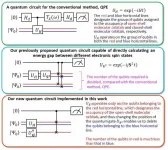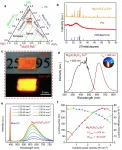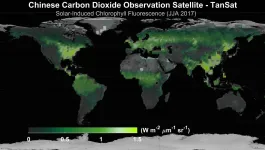(Press-News.org) Singapore, 17 March 2021 - Healthy and cancer cells can look similar under a microscope. One way of differentiating them is by examining the level of acidity, or pH level, inside the cells.
Tapping on this distinguishing characteristic, a research team from the National University of Singapore (NUS) has developed a technique that uses artificial intelligence (AI) to determine whether a single cell is healthy or cancerous by analysing its pH. Each cancer test can be completed in under 35 minutes, and single cells can be classified with an accuracy rate of more than 95 per cent.
The research, led by Professor Lim Chwee Teck, Director of the Institute for Health Innovation & Technology (iHealthtech) at NUS, was first published in the journal APL Bioengineering on 16 March 2021.
"The ability to analyse single cells is one of the holy grails of health innovation for precision medicine or personalised therapy. Our proof-of-concept study demonstrates the potential of our technique to be used as a fast, inexpensive and accurate tool for cancer diagnosis," said Prof Lim, who is also from the NUS Department of Biomedical Engineering.
Using AI for cancer detection
Current techniques for examining a single cell can induce toxic effects or even kill the cell. The approach developed by Prof Lim and his team, however, can distinguish between cells originating from normal and cancerous tissue, as well as among different types of cancer. Crucially, all of these can be achieved while keeping the cells alive.
The NUS team's method relies on applying bromothymol blue - a pH-sensitive dye that changes colour according to the level of acidity of a solution - onto living cells. Due to its intracellular activity, each type of cell displays its own 'fingerprint' which consists of its own unique combination of red, green, and blue (RGB) components when illuminated. Cancer cells have an altered pH compared to healthy cells, so they react differently to the dye, and this changes their RGB fingerprint.
Using a standard microscope equipped with a digital colour camera, the RGB components emitted from the dye inside the cells are captured. By using an AI-based algorithm they developed, the NUS researchers were able to quantitatively map the unique acidic fingerprints so that the cell types examined can be easily and accurately identified. Thousands of cells originating from various cancerous tissues can be imaged simultaneously, and single-cell features can be extracted and analysed. Compared to current standard methods of cancer cell imaging which require several hours, the process developed by the NUS team can be completed in less than 35 minutes.
"Unlike other cell analysis techniques, our approach uses simple, inexpensive equipment, and does not require lengthy preparation and sophisticated devices. Using AI, we are able to screen cells faster and accurately. Furthermore, we can monitor and analyse living cells without causing any toxicity to the cells or the need to kill them. This would allow for further downstream analysis that may require live cells," explained Prof Lim.
Opening the door for faster detection
As their technique is simple, low cost, fast and high-throughput, the research team is planning to develop a real-time version of this technique where cancer cells can be automatically recognised, and promptly separated for further downstream molecular analysis, such as genetic sequencing, to determine any possible drug treatable mutation.
"We are also exploring the possibility of performing the real-time analysis on circulating cancer cells suspended in blood," shared Prof Lim. "One potential application for this would be in liquid biopsy where tumour cells that escaped from a primary tumour can be isolated in a minimally-invasive fashion from bodily fluids such as blood."
In addition, the group is looking forward to advancing their concept to detect different stages of malignancies from the cells tested.
INFORMATION:
A 2020 explosion in Lebanon's port city of Beirut led to a southward-bound, high-velocity atmospheric wave that rivaled ones generated by volcanic eruptions.
Just after 6 p.m. local time (15.00 UTC) on August 4, 2020, more than 2,750 tons worth of unsafely stored ammonium nitrate exploded in Lebanon's port city of Beirut, killing around 200 people, making more than 300,000 temporarily homeless, and leaving a 140-metre-diameter crater in its wake. The blast is considered one of the most powerful non-nuclear, man-made explosions in human history.
Now, calculations by Hokkaido University scientists in Japan have found that the atmospheric ...
PHILADEPHIA - Since the 1990s the rate of spinal fusion to treat lower back pain has been on the rise. A new prospective clinical study published in the journal Neurosurgery, the official journal of the Congress of Neurological Surgeons, found that lumbar fusions were three times more likely to be effective and obtain better patient outcomes, when guidelines for fusion were followed. The results suggest that when surgeons operate outside of what the evidence based literature suggests, patients may not have significant improvements in their quality of life and could have increased pain or other limitations.
"Unfortunately, we don't know how many lumbar fusion surgeries are ...
Philadelphia, March 17, 2021 - Researchers from Children's Hospital of Philadelphia (CHOP) affiliated with the CHOP Epilepsy Neurogenetics Initiative (ENGIN) have compiled a complete genetic and clinical analysis of more than 400 individuals with SCN2A-related disorder, which has been linked to a variety of neurodevelopmental disorders, including epilepsy and autism. By linking clinical features to genetic abnormalities in a standardized format, the researchers hope their findings lead to improved identification and clinical intervention.
The study was published ...
A groundbreaking study has given new insights into how copper deposit-forming fluids are transported naturally from their source deep underground towards the Earth's surface.
A team of geologists, led by Lawrence Carter from the University of Exeter's Camborne School of Mines, has published a new theory for how porphyry copper deposits form.
Porphyry deposits provide around 75 per cent of the world's copper which is in increasing demand for electric vehicles, power infrastructure and green technologies such as wind turbines. They originally develop several kilometres below the Earth's surface above large magma chambers. Not only are porphyry deposits rare but most large near-surface examples have already been ...
A world-first 'flow model' devised by Australian researchers could drastically slash public transport commuter times during peak periods on some of the busiest roads in major cities, new research shows.
When this flow model was implemented to improve the worst traffic bottlenecks across Melbourne, commuters saved close to 2000 hours of travel time during a single morning peak period (7am-9am) and approximately 11,000 hours of passenger travel time during a normal weekday.
Ameliorating major traffic bottlenecks also contributed to a more than 23 per cent improvement in reliability of Melbourne's public transport network, ...
OSAKA, Japan. Quantum computers have seen a lot attention recently as they are expected to solve certain problems that are outside the capabilities of normal computers. Primary to these problems is determining the electronic states of atoms and molecules so they can be used more effectively in a variety of industries - from lithium-ion battery designs to in silico technologies in drug development. A common way scientists have approached this problem is by calculating the total energies of the individual states of a molecule or atom and then determine the difference in energy between these states. In nature, many molecules grow in size and complexity, and the cost to calculate this constant flux is beyond the capability of any traditional ...
High-power laser diode (LD) driven solid-state lighting can generate super-high luminance far exceeding the state-of-art light-emitting diodes (LEDs) source by factors of 2-10, enabling it particularly attractive for automotive headlamp, outdoor lighting, multimedia projectors, laser TVs and so on. Whereas, the thermal shock of laser is extreme, and under intense laser excitation, traditional LEDs phosphor would suffer from luminescence degradation or even failure due to the luminescence saturation. Aiming to overcome this deficiency, highly efficient and stable luminescence bulk phosphors including single crystal, polycrystalline ceramic phosphor and glass ceramic composite phosphor ...
Solar-induced chlorophyll fluorescence (SIF) is emitted during plant photosynthesis. SIF results from vegetation chlorophyll giving off red and infrared light wavelengths when excited by solar radiation. Measuring SIF is important because it is closely related to the terrestrial gross primary productivity (GPP), which calculates the total amount of carbon dioxide fixed through photosynthesis in a given area. According to many laboratory and field experiments, studies show that SIF can effectively improve estimations of GPP, which is necessary for global carbon sink research and carbon mitigation strategies.
China has committed to carbon neutrality by 2060. Technological upgrades and energy structure adjustments through the next four decades will be vital to reducing carbon ...
This is a landmark study in so far as being the first to raise the alarm that, despite early successes with Covid-19 vaccines, further research is warranted on a next generation of Covid-19 vaccines.
The results from this study, however, only indicate that the AstraZeneca vaccine does not have at least 60% efficacy against mild-moderate Covid-19 due to the B.1.351 (N501Y.V2) variant.
Based on a broader body of evidence, the World Health Organization recommends that this vaccine still be deployed in countries where the B.1.351 variant circulates, as it likely still protects against severe ...
Researchers from Skoltech and their colleagues from Hadassah Medical Center have developed hybrid nanostructured particles that can be magnetically guided to the tumor, tracked by their fluorescence and pushed to release the drug on demand by ultrasound. This technology can help make cancer chemotherapy more targeted. The paper was published in the journal Colloids and Surfaces B: Biointerfaces.Current treatments for cancer include chemotherapy, immunotherapy, radiation, and surgery, but these are often not selective enough to target just the tumor ...




